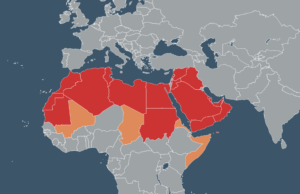اَلْعَرَبِيَّةُ
Working on separate articles for the different variants of Arabic, so stay tuned …
Language Facts:
Speakers: 380 million native speakers, many more second-language speakers
Family: Semetic
Status: Official in Algeria, Bahrain, Chad, Comoros, Djibouti, Egypt, Iraq, Jordan, Kuwait, Lebanon , Libya, Mali, Mauritania, Morocco, Oman, Palestine, Qatar, Saudi Arabia, Somalia, Somaliland, Sudan, Syria, Tunisia, United Arab Emirates, Yemen
Family: Semetic
Status: Official in Algeria, Bahrain, Chad, Comoros, Djibouti, Egypt, Iraq, Jordan, Kuwait, Lebanon , Libya, Mali, Mauritania, Morocco, Oman, Palestine, Qatar, Saudi Arabia, Somalia, Somaliland, Sudan, Syria, Tunisia, United Arab Emirates, Yemen
Script: Arabic script
- Usually, the first step in a language would be to learn the alphabet, but to learn Arabic, the first step will be to choose a dialect to learn. Arabic consists first of Modern Standard Arabic, which is based on Classical Literary Arabic. However, Modern Standard Arabic (MSA) is not spoken as a daily language for the millions of Arabic speakers. Instead, Arabic is split into distinct regional varieties which may not be mutually intelligible with each other. The dialect you choose may be based on the country or countries you have interest in , or media you want to consume.
Some of the larger, general groups of dialects are :
Egyptian Arabic – one of the largest, and most widely understood due to the popularity of Egyptian movies
Levantine Arabic – Spoken in Lebanon, Syria, and Palestine
Mesopotamian Arabic – Spoken in Iraq
Maghrebi Arabic – Spoken in Morocco, Algeria, Libya and Tunisia
- The decision if you want to learn a dialect in conjunction with MSA is up to you. Some people suggest learning MSA first and then branching out to a dialect but for most learners this would a tedious and less rewarding endeavor than learning a dialect, or MSA along with a dialect at the same time.
- The writing system of Arabic is an abjad, meaning that only consonant and long vowels are written. Additional diacritic markings for short vowels are usually included in learning material. The cursive, flowing letters of Arabic is one of it’s most alluring features, but can be a little more challenging that other alphabets/abjads. Letters change form based on its position in a word, and is written right to left.
- Arabic shares with other Semitic languages the unique feature of roots and templates. Base meanings will be contained in a three or four consonant “root”, and then a template of vowels and additional consonants can be added to form into many grammatical functions. For example, the root K-T-B means “write”, and then can be formed into aKTuBu to mean “I write”. A good overview of examples can be found here.
- Word order in MSA can be Verb-Subject-Object, or Subject-Verb-Object. In spoken varients, both VSO and SVO are present, but VSO is not as common in Classical and MSA.
- Present tense “to be” is usually omitted, like in Russian.
- Verbs are conjugated for tense, person, gender, and number and use the same root and template form as mentioned above.
- Arabic has three noun cases : nominative, accusative, and genitive.

Resources
Despite being one of the top languages in the world, the resources to learn Arabic are not as vast as languages like French or Spanish. The many options of MSA vs dialects also dilute the resources available to you. There are still plenty, however, and the best ones are listed below:
Books:
Teach Yourself: Complete Arabic – MSA , complete textbook for a good value.
Arabic for Beginners – MSA , large textbook, free online audio. Lots of important cultural notes included which is important when you learn Arabic.
Arabic: An Essential Grammar– MSA, good reference book for upper beginners. This series is good after some exposure to the language, and will clear up any confusion on grammar points.
Arabic: An Essential Grammar– MSA, good reference book for upper beginners. This series is good after some exposure to the language, and will clear up any confusion on grammar points.
Modern Iraqi Arabic – a large, albeit expensive textbook for Iraqi Arabic.
Colloquial Levantine Arabic – best and most comprehensive introduction for Levantine Arabic.
Moroccan Arabic – shorter, older textbook for the spoken variety in Morocco.
Youtube:
Online:
LingQ– Great platform for reading and vocabulary.
Pimsleur- classic audio based course, has three varieties of Arabic to choose from. Great for pronunciation and vocabulary.